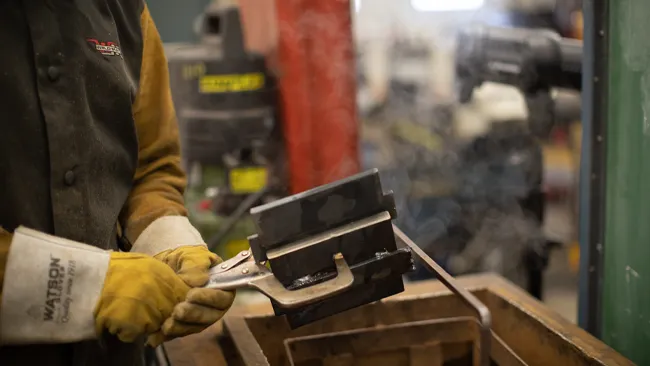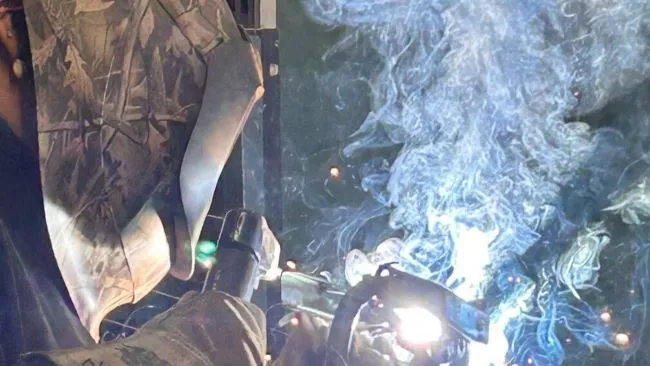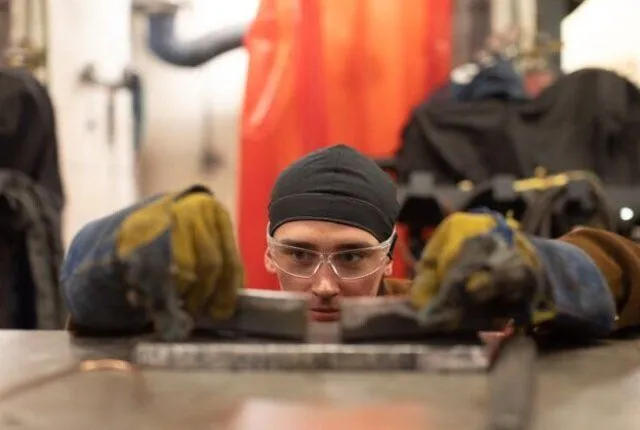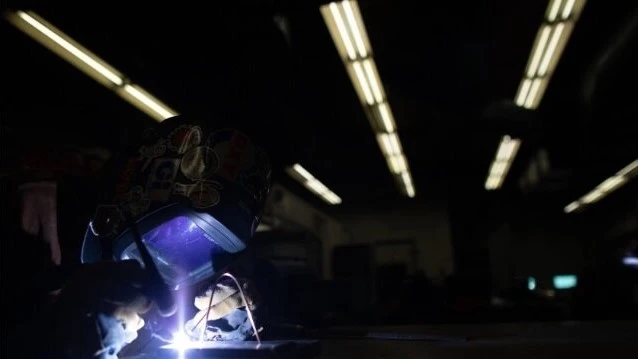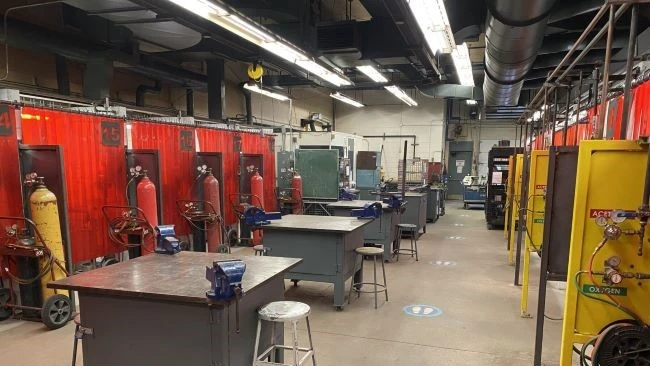
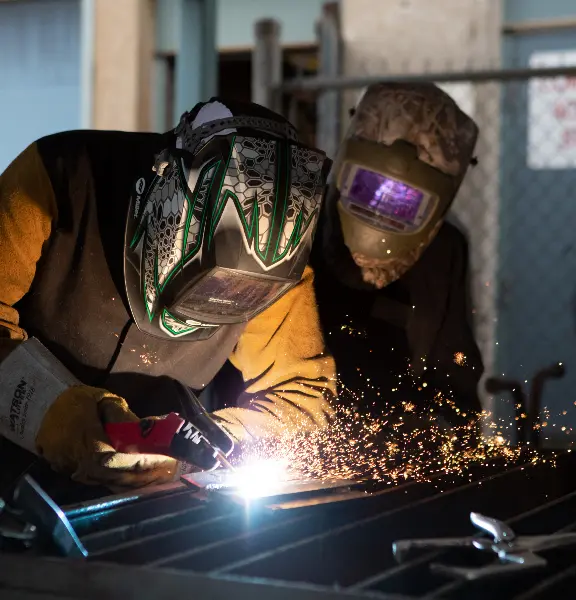
Welding Techniques
Overview
Welding is the common core into all trades. Requiring precise hand skills and dedication, welding can be used for all measures of demand.
Demand for skilled workers in Canada continues to grow, and Lambton College is meeting this demand with programs aimed at creating new skilled workers who contribute to a vibrant local, regional, and national economy.
Welders in Canada are in high demand. As Ontario's construction projects and state-of-the-art manufacturing continue to expand, there will continue to be strong demand for welders in Ontario. The Welding Techniques program at Lambton College is an excellent way to take a step toward becoming a certified Welder in Ontario.
Welding Techniques cover core content used in Welder (456A) and Metal Fabricator (437A) apprenticeship programs. Exceeding competency for hiring needs. Students are given opportunities to challenge their welding skills in practical qualification tests as required by the Canadian Welding Bureau (CWB) and Technical Standards and Safety Authority (TSSA). Extra fees for external weld tests will apply. Graduates of this program who pursue skills and experience in these trades will be taught real life needs employers are seeking.
Graduates of this program who pursue apprenticeships bring valuable practical skills and experience to Ontario employers and make great apprentices in the field.
Admission Requirements
O.S.S.D. or equivalent with:
- Grade 12 English C or U
Mature Student Assessment for this program is available in the subject of English for the purpose of demonstrating proficiency in this required admission subject. For all other admission requirements, applicants must complete the required course(s) as listed above. For more information, please contact counselling@lambtoncollege.ca. Review the Mature Student Admission process.
Academic admission requirements can be obtained through Academic Upgrading and the Pre-Programs at Lambton College.
Costs
- Year 1 $4,156.71
Please Note: These fees apply to the 2025-2026 academic year and are subject to change. Fees do not include books (unless specifically noted), supplies or living costs.
Additional Fees
-
Welding Personal Protective Equipment$500.00
-
Steel Toed CSA 8" Boots$150.00
-
Boot Cut Jeans$30.00
-
Books$230.00
-
Welding Tests (CWB, TSSA)$200.00per process and position
Technology Requirements
In order to keep pace with the requirements of each and every course in your program, Lambton College requires that each student have access to a laptop while studying at our college.
Labs & Equipment
Courses
Manual Welding Processes I
In this course, students develop their knowledge in welding safety, WHMIS, shielded metal arc welding (SMAW) equipment/electrodes, soldering, brazing, braze welding, and oxy-fuel welding. The student will be taught to describe the functions and controls of welding power sources in accordance with government safety regulations, manufacturer's recommendations and approved industry standards. Student will learn to perform fillet and groove welding with SMAW in the flat and horizontal position with a focus of meeting or exceeding the testing requirements of CSA W47.1 regarding weld quality.
Fitting & Layout
This course provides students with hands-on experience in assembling complex projects using various hand and power tools. Students will learn to accurately use measuring tapes, identify workplace hazards, and adhere to industry regulations. A critical component of the course is the integration of mathematical concepts with fabrication techniques, demonstrating the practical application of math in real-world settings. Students will gain the proficiency in the setup and safe operation of key equipment such as oxy-fuel, plasma arc, and carbon arc cutting tools, ensuring they meet industry standards and practices and build a good foundation for preparation and fitting of open-root weldments.
Semi-Automatic Welding Processes I
This course covers the fundamentals, construction features, selection process, and consumables of the semi-automatic process. Students develop basic welding skills with the semi-automatic welding process including Gas Metal Arc Welding (GMAW), Flux Cored Arc Welding (FCAW), and Metal Cored Arc Welding (MCAW). Students will produce padding welds in the 1P (flat) position, fillet welds in the 1-3FW (flat, horizontal and vertical) positions and groove welds in the 1FG (flat) position. Students will learn to perform fillet and groove welding with semi-automatic in the flat and horizontal position with a focus of meeting or exceeding the testing requirements of CSA W47.1 regarding weld quality.
Metallurgy
Metallurgy serves as the foundational knowledge for welding. Students gain essential insights to interpret and assess materials relevant to their future employment. Understanding metallurgical principles is crucial, as material choices significantly impact longevity and practical applications. Topics covered include metal and alloy production processes, steel classification, heat treatments, material selection, corrosion prevention, and mechanical testing (both non- destructive and destructive). By adhering to safety regulations and industry standards, students will acquire fundamental metallurgical knowledge related to welding and fabrication.
Workplace Communications
In this course, students write and speak in response to realistic workplace scenarios to build practical communication skills. They produce, revise, and edit written communication geared to the workplace and practice the oral communication and effective listening skills that will help them succeed in professional environments.
Manual Welding Processes II
Students will continue the review of welding processes including weld faults, destructive and non-destructive measures of inspection and distortion, and will be introduced to submerged arc welding (SAW). Students will expand their skills in shielded metal arc welding (SMAW) and in vertical and overhead positions, complying with CSA W47.1 standards. Students will apply their fundamental knowledge to enhance their welding skills, using techniques learned in the previous term. Upon successful completion of this course, students will be qualified to challenge Canadian Welding Bureau (CWB) certifications and will have up-to-date skills in creating resumes and cover letters for welding-related positions.
Advanced Welding Processes
In this course, students will explore various welding techniques and safety practices. The curriculum covers shielded metal arc welding, semi-automatic welding, and oxy-fuel cutting. Students will learn material preparation using advanced welding methods. Practical skills include producing welds in the 1-4G plate and 6G pipe positions. Additionally, students will gain proficiency in open-root welding (without backing plates), basic stainless steel and aluminum welding, rigging, knots, and hand signals. All practices align with government safety regulations, manufacturer recommendations, and industry standards.
Gas Tungsten Arc Welding Processes
This course introduces the principles and operation of Gas Tungsten Arc Welding (GTAW) equipment, including power sources, controls, and accessories. Students will learn to safely set up and operate GTAW systems for various applications, troubleshoot equipment, and perform welds on mild steel in multiple positions. Emphasis is placed on shielding gas requirements, weldability challenges, and post-weld inspection and preparation.
Blueprint Interpretation & Drawing
This course develops the student's ability to communicate though weld engineered drawings and sketching. Welders require the ability to sketch, read, and interpret blueprint drawings. These skills are necessary in order to comply with drawing standards and specifications while welding and fabricating. Topics in this course include sketching orthographic and isometric views, dimensioning, the title block and drawing notes. In addition, section views, detail and assembly drawings will be examined including bill of materials. Structural steels shapes, and piping will be explored with respect to project drawings. Students will explore joint design and welding symbols to help interpret blueprints. By the end of the course, students should be able to read a welding blueprint.
General Education Elective
Contact
Nikki Noble
PROGRAM COORDINATOR
Applied Science, Engineering Technology & Trades
Program Information
After Graduation
Employment Opportunities
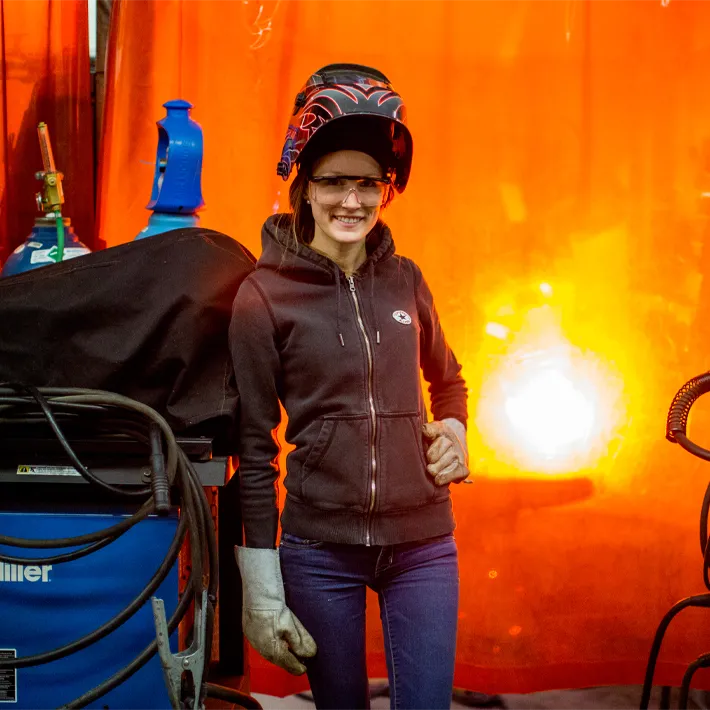
Successful students have the opportunity to branch out into many different career paths in the welding industry after completion of the program including union and non-union placements like: Welder, Welder-Fitter, Boilermaker, Pressure System Welder, Iron worker, Industrial Mechanic/Millwright, Pipe fitter, Steamfitter, Sheet Metal Worker, Fabricator, Maintenance Welder, Steel Artist, Robotic Welder Operator, Welding Inspector, Self-Employed Welder, and more. Some of these positions fall under different responsibilities within construction, service, and maintenance.
Please Note: Availability of jobs will depend upon the local economy.
Accreditations & Certifications
Canadian Welding Bureau
Students have an opportunity to challenge the Level I Welder 456A apprenticeship test on location after completion of the program (Students may also challenge Level II and III pending previous experience and credentials.) Students will be given the opportunity to challenge the Canadian Welding Bureau (CWB), Technical Standards & Safety Authority (TSSA), and in-house multiple process and position welding certification upon results. Students complete the program competent and ready for the workforce.
More Information
Empowering Women to Lead in Tech & Trades
Our Women in Technology & Trades (WiTT) is a vibrant community dedicated to empowering women to thrive in tech and trades. Through mentorship, industry connections, and skill-building programs, WiTT breaks down barriers and fosters an inclusive environment where women can confidently pursue their passions and careers.
Together, we’re shaping a diverse and dynamic future.
Learn more about WiTT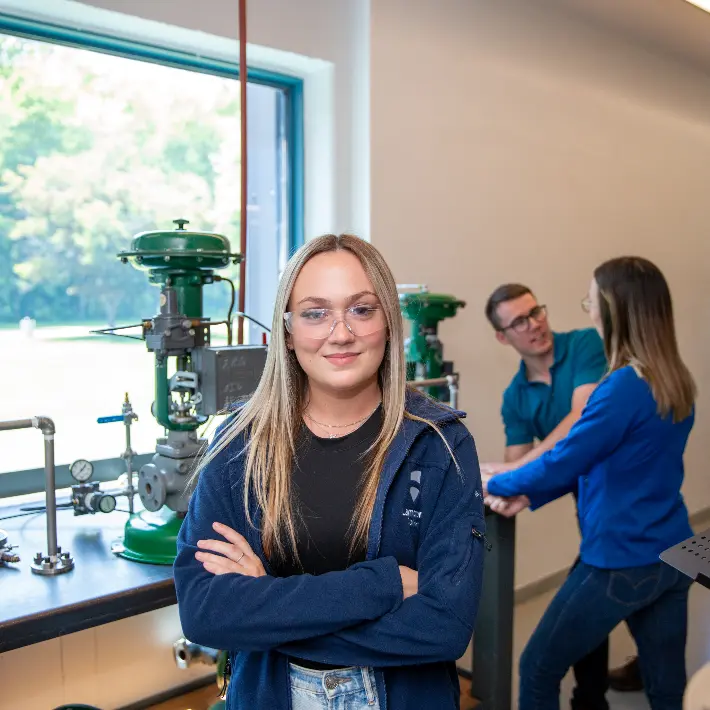
Skill Demands
As we want to ensure success, we strongly recommend students start the program with an updated eye exam from an optometrist. Hand skills can only be as detailed as the student can see. To ensure all the discontinuities are seen, students will need to see this as well in order to improve throughout the program.
Technology Requirements
It is recommended that you use a Windows laptop for your coursework. While other devices like MacBooks or Chromebooks might work for some tasks, they may not support all the software required for your program. If you're unsure, check with your professors before buying.
Internet Speed Requirements
To get the best experience while learning online, we recommend having an internet connection with at least 40 Mbps download speed and 10 Mbps upload speed. This will help you use video calls, attend online lectures, and access other learning tools smoothly.
Because students live in many different areas, we can't suggest a specific internet provider. You'll need to check with local companies to find one that works best for you.
Laptop Requirements
In order to access the internet and virtually-delivered software and courseware, student laptops should include the following at a minimum. By meeting the following specifications, students will be equipped to access software and courseware on their laptop through the internet:
- Intel i5 8th Gen Processor or equivalent
- 8GB of RAM
- 100 GB HDD or more
- Webcam with a microphone
- Wi-Fi capable (802.11n/ac 5GHz)
- Windows 11 operating system
Mobile Device
Students will require a mobile device (smartphone) for:
- Accessing your digital student ID
- Using campus applications and services
Software
To ensure students are getting the most our of their classroom experience, some software will be required.
Lambton College has made this software easily accessible online. Students can leverage our Microsoft Office 365 software packages and services. In addition, much of the software you require for your courses will be available on demand for use on any device - on or off campus.
